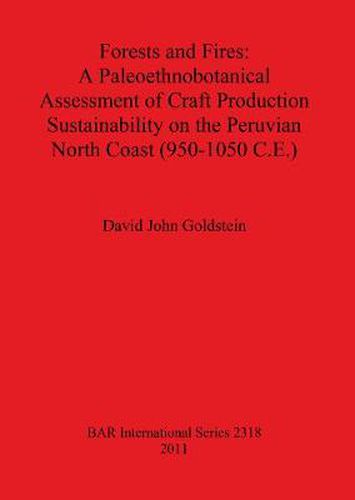Readings Newsletter
Become a Readings Member to make your shopping experience even easier.
Sign in or sign up for free!
You’re not far away from qualifying for FREE standard shipping within Australia
You’ve qualified for FREE standard shipping within Australia
The cart is loading…






This title is printed to order. This book may have been self-published. If so, we cannot guarantee the quality of the content. In the main most books will have gone through the editing process however some may not. We therefore suggest that you be aware of this before ordering this book. If in doubt check either the author or publisher’s details as we are unable to accept any returns unless they are faulty. Please contact us if you have any questions.
During the Middle Sican period (C.E. 950-1050) on the North Coast of Peru, artisans developed a sophisticated tradition of ceramic and metalworking production amidst dry coastal forests of the region. Organic fuel resources, specifically wood, clearly played a vital role in the manufacture of these objects; however, this component of production has been largely overlooked. Thus, a major gap in our understanding of the relationship between Sican period production and the local landscape has developed. The Sican Archaeological Project (SAP) suggests that the production of metal and ceramics during this period likely placed the local fuel resources under considerable stress. Yet, an evaluation of the archaeological data is essential to assess the degree of overexploitation, identifying the fuels used, their contexts for use, and their role in local ecology. This study interprets how Middle Sican artisans met their fuel-wood requirements for production in light of easily endangered forest resources. An examination of the archaeological charcoal from Middle Sican period kilns, hearths, and metal furnaces permits the reconstruction of fuel use and the ecological setting of production. This unique site demonstrates the concurrent production of metal and ceramics, as well as the presence of domestic activity. Using wood anatomy of fuels recovered from archaeological features, the author identified the fuel materials of different use contexts.
$9.00 standard shipping within Australia
FREE standard shipping within Australia for orders over $100.00
Express & International shipping calculated at checkout
This title is printed to order. This book may have been self-published. If so, we cannot guarantee the quality of the content. In the main most books will have gone through the editing process however some may not. We therefore suggest that you be aware of this before ordering this book. If in doubt check either the author or publisher’s details as we are unable to accept any returns unless they are faulty. Please contact us if you have any questions.
During the Middle Sican period (C.E. 950-1050) on the North Coast of Peru, artisans developed a sophisticated tradition of ceramic and metalworking production amidst dry coastal forests of the region. Organic fuel resources, specifically wood, clearly played a vital role in the manufacture of these objects; however, this component of production has been largely overlooked. Thus, a major gap in our understanding of the relationship between Sican period production and the local landscape has developed. The Sican Archaeological Project (SAP) suggests that the production of metal and ceramics during this period likely placed the local fuel resources under considerable stress. Yet, an evaluation of the archaeological data is essential to assess the degree of overexploitation, identifying the fuels used, their contexts for use, and their role in local ecology. This study interprets how Middle Sican artisans met their fuel-wood requirements for production in light of easily endangered forest resources. An examination of the archaeological charcoal from Middle Sican period kilns, hearths, and metal furnaces permits the reconstruction of fuel use and the ecological setting of production. This unique site demonstrates the concurrent production of metal and ceramics, as well as the presence of domestic activity. Using wood anatomy of fuels recovered from archaeological features, the author identified the fuel materials of different use contexts.